

Lauren McCarthy - NanoJapan 2014
University of Florida
Major: Chemistry
Class Standing: Sophomore
Anticipated Graduation: May 2016
NanoJapan Research Lab: Solid State Spectroscopy Group, Prof. Takashi Arikawa, Kyoto University
NanoJapan Research Project: ![]()
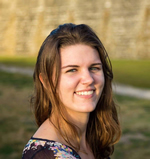
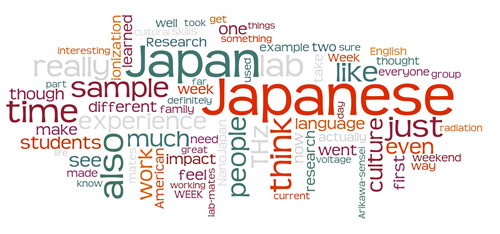
Why NanoJapan?
I chose to apply to NanoJapan because I wanted a summer experience that would combine my love of science and my desire to study abroad. Living in Japan for three months will be a life changing experience for me both personally and professionally. Professionally, participation in NanoJapan will allow me to gain experience in my chosen field by working in the best labs in Japan and learning from the leaders of the nanotechnology field. I feel that participation in NanoJapan will allow me to confirm my goal of earning a Ph.D in physical chemistry and continuing on to a career in academia. I am also excited to experience working abroad because it is crucial for young scientists and engineers to have international experience.
Personally, I hope that this summer opens my eyes to the world around me. I have lived a relatively sheltered life and I am eager to experience the world beyond my bubble. This experience will teach me just as much about life as it will science. This summer, I will learn to be more outgoing and independent, and more understanding of different cultures. Ultimately, participation in NanoJapan will play a significant role in my further development as a scientist and as a person.
My goals for this summer are to:
Reflections on the Meaning of NanoJapan
NanoJapan has been one of the most impactful experiences of my life. When I think about the person I was at the beginning of the summer, compared to who I am now, I think a lot about me has changed for the better. I am now a more respectful person with an international focus. I learned so much more about semiconductor devices and Japanese culture than I ever thought possible in three months. In addition, I learned so much about myself and my background. NanoJapan is more than just the sum of its reactants. It is not just a study abroad program in addition to a research experience; there is a third mystery wonder element that it includes, and it is for this reason that I got so much out of the program.
Research Internship Overview
My research project focused on studying a well-known phenomenon in bulk semiconductors – the Gunn Effect and subsequent impact ionization – in nanostructured devices. I worked on studying the nature of the large jump in current (impact ionization) after oscillations in current (Gunn Oscillations) provided the necessary electric filed within the device to make the current increase so rapidly. To do this, I did three main types of experiments. 1) I studied the current response to an applied voltage over time 2) I studied the dependence on sweeping rate of the current response to an applied range of voltages and 3) I studied the current-voltage (IV) characteristics of the sample both with and without the presence of near infrared radiation. My conclusions from these studies were that the impact ionization seems to occur somewhat randomly in the device and that future work should focus on controlling this behavior.
This project was very heavily physics and electrical engineering based. Though my academic background is in chemistry, my past research experience has been in physical chemistry – heavy on the physics. So, in short, this project was outside of my previous focus, but only a stone’s throw away. My experience working on an international team was wonderful. I especially appreciated how well we all worked together due to the level of respect we each had for the other. I had already planned on continuing my studies to the graduate level, and my experience with NanoJapan only strengthened this conviction, but added a newfound desire to strive for more international research collaborations.
Everyone in my research group was just incredible. My mentor, Arikawa-sensei, was very patient, helpful, and approachable. I felt comfortable coming to him with any questions and he always dropped whatever he was doing to come help me. He made it clear that my project was a priority for him. Tanaka-sensei and Naka-sensei, the full and associate professor, were very kind and spent a lot of time with the students at lunch and in mentoring capacities. My lab group spent a lot of time together and the group environment provided me with a family-like atmosphere. Everyone worked very hard and was really focused on their work. I did socialize a lot with my lab-mates outside of work. They were really great company to get dinner with or go sightseeing with.
Daily Life in Japan
My days began with a ten minute bike ride to work. I would get in between 9:30 and 10:00 and would spend the morning catching up on email, reading, studying Japanese, and beginning experiments. I ate lunch every day with my lab-mates. In the afternoon, I would continue with experiments and processing data. In the evening, I would catch dinner with my lab-mates, or would sometimes get dinner at the cafeteria very quickly by myself if none of my other lab mates were staying late. Depending on the timeline of my research, I would stay until 10 pm +/- two hours.
On the weekends, I went sightseeing to nearby cities and spent a lot of time sightseeing with my lab mates in Kyoto.
My favorite experience in Japan was...
Going to Otsu-san to see the Enryakuji Temple. Basically, this was one of the most beautiful places I have ever been. A fellow NanoJapan student, Nicole, and I took a trip here one Saturday afternoon, and after the cable car took us to the top of the mountain, and I had a view of Kyoto below and the mountains around me, I realized that I never wanted to leave Japan. It was a wonderful, but heart-wrenching realization, because of course, I did have to leave.
Before I left for Japan I wish I had ...
Practiced my Japanese more. I could have achieved twice the level of fluency that I have if I had just practiced and studied more regularly before leaving.
While I was in Japan I wish I had ...
Just done more. Even though my summer was packed, I wish that I had been able to see more, learn more, and do more. There is no way that three months is long enough to experience all that Japan and research has to offer.
My first week in Japan has been a whirlwind experience. We have had language classes for 3.5 hours each day, then cultural or scientific lectures in the afternoon. By the time we are finished and have free time, it is already five or six o’clock, and then we all scramble to explore Tokyo! I fall asleep instantly each night because of how busy and fun our days are. I love it here!
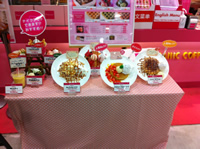
This looks like a tasty breakfast, but actually this is plastic food displaying the menu, this is commonly seen outside of restaurants.
Our language classes have been very good so far. The AJALT (Association for Japanese-Language Teaching) teachers are very talented and very sweet. I feel like I have learned more in one week than I would have in three weeks in a college class. One thing that has helped to learn Japanese is to study it in every bit of down time, most notably, while on the train or subway. It also helps to just be surrounded by Japanese language speakers.
I am already better able to communicate with everyone here, even just after 5 days of study and I am slowly getting better at reading hiragana and katakana. Even so, I have had a couple of mimed conversations thus far, and I’m definitely improving my charades skills.
One thing that is much different than how I expected is how similar Japan is to the United States. Japan is definitely very different from my own country on the surface though. The buildings are coated with colorful advertisements, I eat noodles for breakfast, and of course there are Kanji characters everywhere. Despite the surface differences though, the people are very similar to the people I know and the people I am comfortable interacting with at home. I feel like I am already noticing more similarities than I am differences. We are all human and all have universal gestures, motivations, and feelings. For example, I saw a Japanese couple trying to take a picture of themselves, and I stepped up and held out my hand and said “I can” and without pause, they handed me their camera and I took a picture. This exchange was only possible due to universal gestures.
One difference that I am quite fond of is the practice of bowing. The Japanese bow to each other when just meeting or just departing. It is a sign of respect. Many of the bows are deep and committed, but it is also common to see a more sincere head nod. I am still quite accustomed to the hand shake, but soon, I think bowing will replace the hand shake in my mind as well as carry a deeper significance.
In our free time, we went to Akihabara. Right next to the train station was the craziest most awesome department store I have ever seen. It was the kind of store that sold 16 different telescopes right next to rows and rows of scrapbook supplies and stationary. The variety was like nothing I have ever seen. Not only did the store have one of everything ever made (probably, this place was huge) but it also had 20 different varieties of each item.
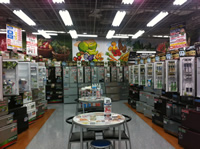
Refrigerator selection at department store. Note: Not pictured are 10 more refrigerators and the Roomba Vacuum selection just across the hall.
We also went to the top of Tokyo Tower. Tokyo Tower is actually taller than the Eiffel Tower, and having been to the top of both, I would have to say that I enjoyed Tokyo Tower more (sorry, France). At the top, there were stunning views of the city with buildings literally as far as the eye can see. The top level of the tower had an astrological theme with really interesting future-style music playing to add to the experience.
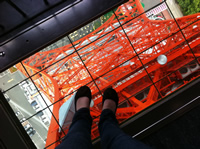
“Look Down Window” on the mid level of the the Tokyo tower.
Overall, I had a great first week in Tokyo and already feel that I have learned so much about Japanese language and Nanotechnology. Exploring the city in our free time has been a priceless experience. I still have questions in the roll that Shintoism and Buddhism play in Japanese culture. We went to Asakusa and saw a Buddhist Temple and Shinto Shrine, they were beautiful. I’m interested in learning more about the spirituality of the Japanese people.
Overview of Research Project at the Solid State Spectroscopy Group, Prof. Takashi Arikawa, Kyoto University
I will be studying a GaAs heterostructure with a quantum point contact, it is a semiconductor. GaAs heterostructures are two dimensional, as they contain quantum wells consisting of GaAs electrons confined to a potential well. Quantum point contacts are narrow, one dimensional channels, between two regions of wide electrical conductivity. Therefore, the system I will be studying is two dimensional with one dimensional regions at interfaces. What is interesting about the material is that it will exhibit Gunn Oscillations which leads to impact ionization causing a THz induced photocurrent. Gunn Oscillations occur in devices exhibiting the transferred-electron effect, so called because the electrons move from regions of high mobility energy minimums to low mobility, higher energy states. This means that at a high field, the drift velocity decreases with increased voltage. Impact Ionization is caused by collisions between electrons in the conduction band and electrons in the valence band. The valence band electron gains enough energy from the collision to be promoted to the conduction band, then that electron collides with another valence band electron, and so forth. 1 I’ll be studying optical properties of my material to understand the quantum mechanics driving the process. My material has the applications of being a room temperature THz sensor.
Riding the train and subway in and around Tokyo is one of my favorite things to do! Looking at how people ride the subway in Japan can give some interesting insights into Japanese culture. Some of the guidelines of riding the subway:
If it is a high traffic time, there is no such thing as personal space. It is actually a scientific fact that there is always room for one more person on the subway or train, no matter how tightly that means you must be packed.
The train is never, ever, ever late. I think this relates back to something that is very important to Japanese culture: be on time! If you are five minutes early, you truly are ten minutes late.
People are very quiet on the subway, and they do not talk on their phones, and if they are talking at all, they are talking very, very quietly to the person sitting next to them.
Typically, people read on their tablets or are looking at their phones while on the subway/train. People also sleep on the subway. Do not be alarmed if a stranger uses your shoulder as a pillow. This hasn’t happened to me yet, but it’s truly a matter of time at this point.
Traditionally, people do not eat food on the subway/train, but I actually saw a young Japanese man eating what appeared to be a hot pocket once. You can eat on the subway, if you absolutely must, but it is not advised, and you will likely be the only one. Also, try not to eat in public; no one eats in public here.
The subways and trains in Tokyo are shockingly clean. There is no garbage anywhere in the station, or in the car, despite the low amount of trash receptacles. This is related back to something very important to Japanese culture: respect. In this case, everyone has such great respect for their city and their fellow citizens that they make sure to take care of their trash.
When it is crowded, you have to get a bit assertive if you need to get off the train. In all cases I’ve seen, this has not been an issue, everyone is as polite as possible, even though they must push past ten or so people who are staying on the train. Also, if you are staying on the train at a popular stop, make sure to anchor yourself to something, or you’ll get pulled off with everyone. This sounds a bit scary, but really, everyone is very polite and calm, this is part of their daily life so they are used to it.
Pasmo and/or Suica passes are awesome. They make paying for your commute very easy and are super nifty. You just touch the pass to the sensor and it deducts the correct amount of money. It would be almost impossible to commute without them.
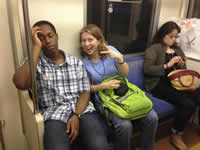
NJ student Chris Miller taking a snooze whilst on the subway with fellow NJ student Julianna Richie listening to music. Not pictured: Chris Salinas, taking pictures of people is what he does while on the subway. Photo Credit: Chris Salinas
I think the Japanese system of transportation is very different from systems of transportation in America. For example, I am always on the run at the University of Florida, often times, two of my three meals are consumed while speed walking to class. It never really occurred to me that this might be rude, but now I can see why it would be. I don’t really want to see people eating all the time, people are messy! This may also just be a practical difference. Much of the Japanese food requires two hands and a bowl, which would be quite difficult to maneuver while in public, sans table.
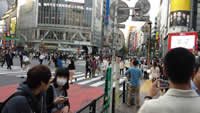
This is the busiest intersection in the world, in Shibuya. This is a prime example of calmness in the face of literally thousands of people in a large crowd. Also, people wear face masks when sick so as not to spread disease.
Another difference is simply the orderly and polite way in which Japanese people conduct themselves in large crowds. Again, this leads back to respect. I can remember a couple of times, when in a large crowd of people in America, becoming frightened due to the sheer number of people. In America, I feel like the chance of becoming hurt in a large crowd is fairly real. However, this is not a fear that I have in Japan. Everyone is far too gracious and polite for me to fear being harmed. Japan gracefully handles the huge amount of people who are commuting, in a way America simply does not have the infrastructure to handle.
In other news, the discussion with the KIP (Japanese) students was great this week! We are all becoming friends and I am excited to go to Kyushu with them this weekend! KIP is a group of Japanese college students who want to become more international. Packard-sensei organizes for them to have discussions with us weekly. Overall, my second week has been busy, fun, and very educational!
Intro to Nanoscience Lectures
Dr. Bird covered many topics of solid state physics and graphene applications to nanotechnology. In the first lecture, he taught us that the properties of material are a direct result of the way in which electrons fill the energy bands, and introduced the concept of a hole. We learned that the energy bands of a semiconductor bend when there is an internal electric field. The first lecture concluded with a treatment of heterostructures, their properties and applications. In the second lecture, we discussed some of the properties of graphene and how these properties are related to the extremely unique band structure of graphene. Graphene is a zero band-gap semiconductor, with electrons that behave like photons! The problem with the lack of a gap is that graphene cannot easily be used as a transistor. There are many scientists looking for a solution to this problem. Dr. Bird’s lectures were very helpful in giving a concrete, understandable introduction to solid state physics.
Maruyama-sensei discussed his synthesis methods for carbon nanotubes. He does Alcohol Catalytic CVD. He also talked about different ways to cut graphene sheets to make differently structured carbon nanotubes. We learned that Raman spectroscopy is an important tool in characterizing carbon nanotubes because the result from Raman can be related to the diameter of the nanotube. He talked about how the chirality of the nanotube determines the bandgap. Maruyama-sensei also gave an overview of his octopus growth method. The chain and cap allow for continuous growth. I was very interested in this method of carbon nanotube growth. I was also very interested to learn more about the potential applications of carbon nanotubes.
Ishizaka-sensei discussed her method of research: ARPES (Angular Resolved Photo-Emission Spectroscopy.) Photo-Emission Spectroscopy is based off of the photoelectric effect. ARPES is able to give you information about the spin, momentum, and energy of electrons in the system. Ishizaka-sensei also varies the light sources used to see more peaks in the spectrum. She also discussed the Rashba effect which is spontaneous spin polarization. I thought her work seemed very interesting. I had never heard of ARPES before so was glad to learn more about it.
Visiting Kyushu this past weekend was an incredible experience! We went to see Mt. Aso, the largest active Volcano in Japan, saw the ancient folk-lore dance of Kagura, participated in a homestay, and interacted with Gokase junior and high school students. My weekend trip to Kyushu has been my favorite experience in Japan thus far.
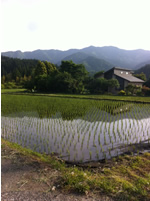
The beauty of Kyushu was pretty unreal. This was taken just down the road from the inn we stayed at the first night.
I really didn’t know what to expect from this weekend trip, but if I had had expectations, Kyushu would have surpassed them all. I cannot describe the absolute beauty of the island. Being from the flat land of Florida, I’m excited to see golf course hills, let alone mountains as stunningly beautiful as these. This weekend trip allowed me to experience the Japan that I expected. Ramya, Nicole, Jade, and I were sitting on tatami mats, with a view of the mountains and rice patties, and suddenly, it fully hit me that I was in Japan! Up until then, I only had a sense that I was physically located in Japan, but after that moment, I knew it emotionally too. It was a great feeling.
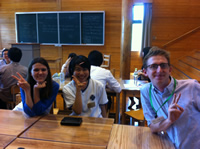
Skylar-san and I with one of the Gokase high school students. We were preparing for our afternoon discussion on Deforestation.
The aspect of this visit that had the greatest impact on me was the kindness of my homestay parents. I felt so honored to even be invited into their home, as it is rare to be invited into a Japanese home. My homestay parents went far above and beyond to make me feel welcome. They made traditional American dishes for me to eat (like potato salad) but also made traditional Japanese dishes (like miso soup) so that I could have a nice mix. They were so interested in where I was from and spent a lot of time sharing their favorite books with me so that I could learn about them too. We ate dinner for two and a half hours, just enjoying the conversation. Just eating dinner with my homestay family was my favorite part of the homestay experience.
My homestay sister had a disability, but I could not tell what type. She was very, very quiet. Her parents cared for her extremely well and there was such peace in their home. In the morning of my second day with them, we all went to a local shrine that had been in my homestay mother’s family for years. My homestay sister stayed behind though. I didn’t understand why. Perhaps she didn’t want to come, but it almost seemed like her parents just didn’t take her out much. I think they are very concerned with protecting her.
My homestay family was also very musical and artsy. Their home was covered in all sorts of trinkets, pictures, and musical artifacts. It was delightfully chaotic. They were very interested in photography and took about a million pictures of me. I was honored to be considered so special to them.
Obviously, the biggest challenge of staying with my homestay family was that I am not fluent in Japanese. I had only had nine lessons at this point, so communication was a struggle. I managed by communicating with a lot of gestures and adjectives that I had learned. Beyond this, there were a couple of cultural misunderstandings as well. For example, after eating some of the pumpkin soup that they served me, I said “totemo oishii desu” meaning “this is very delicious.” Well… my host family interpreted this as “She likes it, we must make more!!” So my host mother got up from the dinner table and went to make more food. This was obviously not my intent. In a Japanese home, you must be careful to not enjoy anything too much, because your homestay family would feel obligated to give it to you.
I definitely got to see one of the main Japanese cultural values in the way that my Japanese family interacted with me. In Japan, I think the mentality is “stuff them with kindness.” By this, I mean that my host family continued to place plates full of food in front of me. They would not stop! I had to waddle away from the dinner table. This is just how Japanese people are, and I’m not complaining! They want to make you feel overly welcome and feel comfortable, and their main avenue to accomplish this is to make sure you are well fed. I think that this definitely works as I felt nothing but kindness radiating from them.
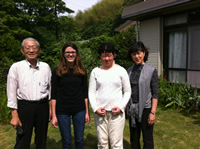
Me with my wonderful homestay family.
This trip taught me that I need to work harder on learning Japanese! It was rather frustrating not being able to communicate in Japanese with my host family. Again this weekend, I was reminded of the kindness of the Japanese people. For example, the 7-page weekend schedule and guide was written entirely in English by the KIP students. It would be a tremendous amount of work just putting that together in your native language, not to mention translating it to your second language.
I also learned that the Japanese people can be very open minded. I was extremely touched when saying goodbye to my family, my host mother threw her arms around me and said “American goodbye” and gave me a big hug! Hugging is definitely not a part of Japanese culture, and my host family was probably uncomfortable to be so close to me, but they did it anyway because they knew that hugging is a part of my culture.
End of Orientation Reflection
As my three weeks in Tokyo come to a close, it is time to reflect on everything. The experience that has been the most helpful was by far all of the nanoscience lectures; I have learned so much! What was least helpful?? I would have to say all the precautions I took to not get lost. Getting lost is actually really fun if you’re with the right people.
Three strategies I have used to learn Japanese: do the homework (sounds obvious, but it isn’t always easy), try to speak it with people, even though you would rather use English, and finally, try to come up with a question to ask every day (in Japanese). Most useful to learning Japanese has just been to make an attempt to speak it whenever possible, and try to listen to the words being said around you. The most important thing that I know now, that I didn’t before, and this will sounds silly, but all of the signs have English translations! Yes, yes, I am supposed to be practicing my Japanese, but it’s really nice to not have to decipher a sign for twenty minutes.
Three burning questions I still have:
These last three weeks have been some of the best of my life. I am in love with Tokyo and cannot believe how close I have grown to all of my fellow NJ students. They feel like family to me and I am very sad to say goodbye to them for a month. That being said, I am beyond psyched to go to Kyoto!
Intro to Nansocience Lectures
During the first lecture, Dr. Stanton reviewed the basics of quantum mechanics and introduced the concept of spaghetti plots. We learned that though spaghetti plots seem very complicated, they are really just a measure of energy versus wave vector (k, a measure of momentum). Dr. Stanton taught us that in order for an optical transition to be allowed by conservation of momentum, transitions in k-space must be strictly vertical. We discussed the photovoltaic effect and how light shining on a semiconductor can create a photocurrent. During Dr. Stanton’s second lecture, we discussed femtosecond laser spectroscopy. Femtosecond laser spectroscopy allows one to study the scattering mechanisms within a system through its “stop action” properties. We also discussed the basics of pump-probe spectroscopy and talked about the Gunn Effect. Finally we discussed the generation of THz waves. I found the discussion of the Gunn Effect to be very interesting, especially because that is a large part of my project. I also enjoyed learning more about spaghetti plots. I had seen them before, but hadn’t yet been formally introduced to them.
Otsuji-sensei gave a wonderful, interactive talk on graphene and THz spectroscopy. His lab was able to differentiate between different types of tea leaves just through THz technology. This is a fun example of a powerful scientific tool. Otsuji-sensei gave a very reachable definition of the density of states: the number of seats available at a game. We talked about the potential for graphene to bridge the THz gap and covered the basics of graphene. Finally we discussed plasmons and how they can dramatically increase the THz gain.
My first day in Kyoto was very pleasant. Arikawa-sensei is an assistant professor at Kyoto University and is also my mentor/supervisor for research. I am very lucky to have him as my supervisor because he is so kind and he laughs easily. He and his wife Chie took the time to come pick me up at the train station. They then took me to my apartment and translated for me the instructions of how to use everything, and took me to the grocery store. Arikawa-sensei even provided me with a portable wireless router! The wifi situation during my first three weeks was really spotty so I was very excited about this. I was so thankful that he took the time to make sure that I was so well settled.
Arikawa-sensei was very nice to allow me extra time to sleep for my first day. He met me at my apartment at eleven in the morning and walked with me to the lab. I was very warmly welcomed by everyone in the lab, and I think that they enjoyed my American candies. I brought them some Starbursts and Jolly Ranchers, which they definitely don’t get here. They took me to lunch, and in the afternoon I got a tour of the lab and had some time to read and work on my weekly report. Yuji-san sits directly next to me and he is very friendly and helpful. I am glad because sometimes he asks me questions about how to say something technical in English, so I feel like I can help him too. Everyone speaks Japanese to each other, but will speak very good English with me. I think this is the perfect mix. I will be able to be surrounded by Japanese but it won’t be a complete hindrance that I am not fluent. I’m a little concerned that I will really have to push myself to practice though, Japanese since my lab mates speak such good English.
I am really enjoying spending time with my lab mates. My second night, I had dinner with Hikaru-san at her house. Her apartment was very nice, and literally everything she owned was pink. It was awesome! One of my other lab mates, Tomo-san, joined us and he served as our translator for the evening, as he was the most fluent in English. We had a great night just talking and I taught them some English phrases, and Hikaru-san practiced her English with me, and I practiced my Japanese with all of them. We all laughed kindly at each other over our mistakes. Thankfully, they walked with me all the way to my apartment at the end of the night so that I wouldn’t get lost!
My apartment is very nice and much bigger than I expected. The space I have here is far bigger than the space I have in the US. Everything is included too. I have a kitchen and a laundry machine, which is very nice. In, fact, my kitchen comes with a rice cooker and an instant hot water heater! I also have a large full size bed, which is a huge improvement over the shockingly small beds in the dorms at UF.
I have started my research project a little. Mainly this week has been focused on getting oriented and trained. I have spent the bulk of this week reading up on theoretical information and studying Japanese. On Friday, there was the Lorentz festival, an open house for the university. I spent a good amount of time touring the labs of the department. It was pretty awesome!
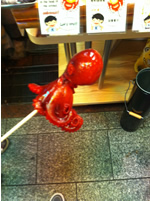
This was the strange octopus dish we ate at the market. I was so scared to try it, but it was really good!
This weekend, I went sightseeing with two of my lab mates: Tomo-san and Yuji-san. We went to a crazy awesome food market where I got this octopus-egg-thing you can see in the picture. They also took me to a famous temple and shrine. At the temple we went into a pitch-black cave that is supposed to represent a womb. At the bottom there is a wishing stone. This sounds really strange, but it was actually really fun and an interesting cultural experience. We then went to a beautiful park and relaxed after a long day of walking around, and I spent some time teaching my lab mates various American phrases. We ended the day by walking along the riverside and sitting by the bank of the river while the sun set.
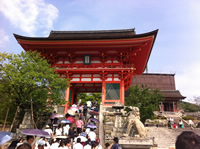
This was the gate to an amazing temple!
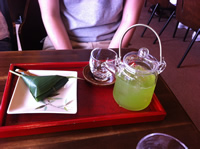
Pictured here is the teeniest-tiniest-cutest iced tea kettle I’ve ever seen. We got it on the way to the temple.
Research Project Overview
The sample that I will be working with is a GaAs/AlGaAs heterostructure with a 180 nm constriction. The current-voltage characteristics have been well studied by Dr. Bird’s group. My task, simply put, is to see how the current-voltage characteristics change in the presence of THz radiation.
Research Project Methods/Instruments: To study this sample, I will be using a lot of different instruments. The experimental set up to which I have been assigned includes a Ti:Sapphire laser with a power amplifier. It is a pulsed laser with pulse lengths of 100fs and repetition frequency of 1KHz, it’s wavelength is 800 nm. Each pulse is 4mJ in energy. In total, the original beam is split into 4 beams. 3mJ of the beam goes into THz generation, and 1mJ goes into the pump and probe beams. The THz radiation is generated by the 3mJ beam being split into one that has λ=800nm and its second harmonic that has λ=400nm. The two beams are mixed in air to create plasma (ionized air). The plasma then generates the THz radiation. I will be using a Keithely 2400 source meter, controlled by labview to take measurements of the device and supply voltage to the sample. I will ideally be using the same program that was used by Rui to take the original current-voltage (IV) curve.
Right now the plan is for me to use two different methods to take data, methods that are very simple in principle. The first is to sweep the bias applied to the sample over a certain voltage and back down again, measuring the current response. I will repeat this measurement in the presence of THz radiation. I will then subtract the curves to determine the photocurrent produced by the THz laser. The other method is to apply a bias to the sample, and keep the bias constant for a minute or so, then apply THz radiation and measure the change in current. Then I will step the bias. The two regions of the IV curve that are of particular importance are the nonlinearities below 1V and the hysteresis that occurs between roughly 10 and 15 V of bias.
What will be very interesting to observe is what happens to the IV characteristics when a bias of 0.25 V is applied, and then applying very high powered THz radiation. We expect to see a measurable photocurrent produced.
Thankfully, as my project is a piece of an ongoing, well established project, much of my work has already been completed. The THz system is ready to go, a sample holder was already made by Xavier last year, and a program for measurements has already been designed. I just need a bit more training and then I will be ready to take some great data!
Training: I spent about five-six hours this week training myself on labview. I was following a tutorial given to me by Arikawa-sensei. I also spent a large amount of time reading up on theoretical information by reviewing papers, manuscripts, and presentations. I took an extensive tour of the lab and got a lot of background information on the experimental setup. Arikawa-sensei and I worked together to adjust the sample holder so that the correct pins would be in the circuit. I still need training on the THz system. I also need to spend more time with labview in the case that I may need to program something. At this point, I am merely able to program simple loops and operate the programs. Additionally, I will need training on proper mounting of the sample and data processing.
Timeline: My first task is to work with Arikawa-sensei to get an IV curve of the sample over the range of -25 to 25 volts without any THz radiation in order to get a baseline for the sample and in order to confirm that I can reproduce the measurements taken Dr. Bird and Rui. This should be completed by the end of next week. At that point in time we will discuss with Dr. Bird steps to move forward. The THz system that I will be using to take measurements following the first task is up and running, so I can proceed immediately with taking data.
My first three weeks in Japan were awesome, but they were heavily Americanized. I spent almost all of my time with my fellow NJ students, which was really great, but as a result, some small cultural differences went unnoticed by me. For example, I have learned that in addition to all the things that I need to remember are a part of the common sense in Japan, there are a few things that are a part of my common sense that seem really weird to everyone here. Finding these differences has actually been fascinating for me. For example, what do you do when someone sneezes? You say “Bless you!” right? Wrong! What about when you meet up with a friend, or say hello to a co-worker, you ask them how they are, right? Wrong again. As far as I’ve seen, it just is not a part of Japanese culture to ask someone how they are.
My first few days in the lab, I would walk in and ask the person sitting next to me how he was, after saying “Ohayo Gozaimasu” of course, and he would say very fine, and then not say anything. The same thing would happen with all of my other lab mates too. I kept wondering why no one was asking me how I was, after I asked them. Then it came up in conversation, and it was explained that everyone is a little confused when I ask them how they are, this just isn’t something they do. I then explained that it is part of an American greeting, and that in America it is seen as rude to not ask someone how they are after they have asked you. I feel a little bad, because I think my lab mates thought that I was saying I would think that they were rude if they didn’t ask me how I was, so now, my lab mates ask me a few times a day how I am.
I thankfully haven’t had any major cultural miscommunications (at least none that I have noticed) and have only had some minor things, like forgetting to take my shoes off when entering a dressing room, a major no-no. I’m such a magnet for awkward interactions even in American culture that it is no surprise that I would have many to share from my time in Japan.
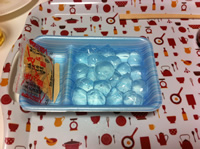
Rice dessert that we ate at dinner. It looks like giant water droplets! Japan has some interesting treats.
I’m really enjoying learning more about Japanese culture from my lab mates. I just hope that I am not upsetting them when I compare their culture to American culture. I really just find the differences very interesting and like to share them, hoping that they find it interesting too. I’m trying to stop doing this though, for worry that it is giving the impression that I do not appreciate Japanese culture.
Bowing update: I don’t think I can meet someone without bowing now. Even last week, I was introduced to an American professor, and bowed to him! A lot of times, people will offer me their hands to shake, but it is now my habit to bow, so I end up awkwardly doing a half shake half bow sort of thing.
This weekend, on Saturday I went to Kobe with Nicole and we tried Kobe Beef. It was incredible and has ruined me for all other food, ever. I will probably have dreams about this meal for years to come. Then on Sunday, I went to a very famous shrine in Kyoto called the Fushimi Inari Shrine with Yuji-san and Tomo-san. The Shrine has thousands of Torii (the shrine gates.) There were so many gates, that when you put them together, they made a tunnel. We also went to Karoake. My personal advice is to not attempt a One Republic song because the background music of the song does not give you much indication of the key you should be in. Try a Coldplay song because Coldplay’s music is very instrumental, so even if you have trouble finding your voice, it will still sound like a recognizable song.
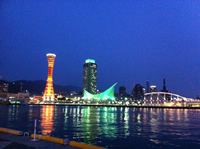
Kobe’s Harborland
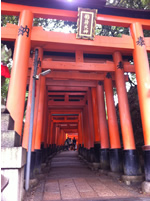
Fushimi Inari Shrine, this is only a sampling of how many Torii there were!
I’m not sure if my lab in Japan is typical, but I think that it is a pretty awesome environment to work in. In my lab here, my mentor is an assistant professor, and is very, very understanding when I make mistakes (I broke all of the gold wiring on my sample my second week here, and I couldn’t believe how nice he was about it), and also very happy to walk me through any process. As my mentors in the US are really awesome and understanding as well I feel there is not a difference between the two environments here. The differences between US labs and Japanese labs sort of begin in other areas, for example, in Japan the groups are bigger and often have a full professor, associate professor, and assistant professor working for them.
In regards to how people interact in the lab, I see a lot of the cultural values of the Japanese in play. For example, Arikawa-sensei never actually tells me to do anything. Instead, he suggests something with a “maybe you should read such and such paper” I always have to translate this to “American” to mean “you better read this right now.” At first, I had a bit of difficulty adjusting to the indirectness, but now that I am adjusted I see the merits of both systems and feel I can operate with both. I also have tried adjusting my own manner of speaking, even over simple things. For example, we were about to take measurements of the sample and I said, ever so cautiously “maybe we should secure the sample holder to the table.” In the US, I probably would have just said, “let me secure the sample to the table.” Even here though, that may have been too forceful a statement. When Japanese learn English they are taught that “should” is used to command someone to do something.
I also see the importance of a group consensus come into play. Oftentimes Arikawa-sensei will confirm with me the validity of a plan, making sure I agree with him that it will work, even though I don’t have near the experience that he has. Also, when people disagree, they don’t tell each other that they disagree. I think we save time in the US by being direct, but in Japan, harmony is so much more important than time.
Finally, I see the practice of taking off ones’ shoes extends to the lab setting. When you enter a Japanese home, traditional restaurant, or traditional Inn, you ALWAYS take off your shoes. There is usually a difference in elevation of the floor to indicate where you need to take off your shoes. You only wear your socks on the higher elevation and you are sometimes given slippers to wear around too. In the lab, you also take off your shoes before entering, and are given lab slippers. I was really surprised to discover this, as you usually want to wear very sturdy shoes in the labs in the US.
Group meetings here are about 15 minutes, and they are followed with a quick lab cleanup complete with a cute chore chart for each member. About 5-8 people from the group eat lunch with each other every day. Arikawa-sensei, the associate professor Naka-sensei, and Tanaka-sensei often join us. I can definitely tell that group culture is very important here. I think people would be concerned, or even offended if I didn’t eat lunch with them.
People follow the traditional rules here of how to address someone, for the most part it was what I expected, except for one notable difference, which I’ll describe shortly. Everyone here is known by their last name, and their last name either has a –san, -kun, or –sensei attached to it. -San is used for anyone older than you, or a female younger than you. –Kun is used for any male younger than you or for any male your own age. –Sensei is used always for the associate and the full professor. Interestingly enough, Arikawa-sensei is often called Arikawa-san, even by the first year students. I am not sure why this is. Perhaps because assistant professors are often close in age to the students, -san is still acceptable. This is likely the reason, but it could also be because Arikawa-sensei is so approachable and he works in the same room as the rest of us.
I think a sense of group is most valued here. Of course results and hard work are important, but not more important than being there for each other. Last week, the group got together for the welcome party for me and a few other undergraduates joining the group. EVERYONE was there. It didn’t matter if you were busy with experiments or a report, you were going to go to that welcome party. I feel like in the US, it would have been very acceptable to skip out on something like that if you were busy with work. The students here work very hard, but I was actually expecting to see more long hours being pulled. People do work on the weekend, but they don’t work too late at night usually, so I think that kind of makes up for it.
I like both systems of work equally. In the US I think working hard and good results are most valued. I think you are also forgiven for bad results as long as you were trying and working hard. The system in the US is something I feel comfortable with. I know how to operate within it: I just work, and work some more. Here, I’m not as sure that I understand how to become a valued member.
On a completely different note I was very surprised to learn that school clubs don’t exist in Japanese universities. University of Florida has over 900 student organizations, and I take my extracurricular activities very seriously, so I was shocked to learn that student organizations are not a thing here. But then I thought about it. One of the students here said that the reason is Japanese are so shy, but I also think that because Japan has a group culture, they don’t need to form student organizations, they are already a part of a big club. In the US though, we are so individualistic, that we need to form groups in school because otherwise, we would never make any friends or feel like we belonged to a group.
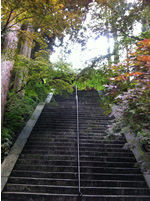
Nicole-san and I went to the Enryakuji temple on the Hieizan Mountain this weekend and it was phenomenal! Definitely off the beaten path for foreigners, this made it even more exciting. We even got to peak in on a Buddhist ceremony!

I went to an American-styled diner here and got what I think was a pancake. It was pretty awesome, but on top of the pancake is actually ice cream, not whipped cream!

I’ve never been so excited in my life to eat a McDonald’s meal. Six weeks of living in Japan will do that to you… I spent about 15 minutes ranting to my lab mate that all I really want in life is a Big Mac, so this meal was definitely necessary.
Research Project Update
This week was focused on ensuring that I could get a reproducible current-voltage (IV) curve over the range of -1 to 1 V. To do this, I took about 30 IV curves over separate days and separate times of the day. Dr. Bird, Rui, Arikawa-sensei, and I agree that the curves are reproducible enough to proceed with our THz experiment. The experiment will involve sweeping a source voltage from -1 to 1 V both with and without the presence of THz radiation. Subtracting these curves from each other will allow us to see the effect the THz radiation has on the current and measure the photo-induced current.
My biggest accomplishment so far I think was when some Japanese students were talking about taking me sight-seeing around Osaka. They were speaking in Japanese but I understood, due to context clues, gestures, and words that I could pick out. At the end of the exchange, one of the students said “itsu” which means “when?” and I said, without thinking “I don’t know.” The student said “you can understand us??” They were really impressed and surprised that I had understood any of what they were saying. Little things like this have been happening a lot recently. While I can easily ask simple questions, like “when does work begin?” “What is that?” “Does this train go to Kyoto?” etc. I find it very difficult to actually make statements more complicated than “this is delicious.” The cool thing that has been happening recently though, is that I can understand a lot of what people are saying, even if I cannot figure out how to say it myself.
My biggest personal challenge to this point is hard to pin down. There is the ongoing challenge of needing to be so much more careful of everything I say. My lab is like a small town, anything that I do, everyone finds out about it without my knowing how they found out about it. As a result, I need to be very cautious in what I say because if I say anything even a little negative, I never know who could find out about it and be upset. In addition to what I actually say, I also need to be cautious of how I say it. I am always worried “my American is showing” because I think that I say things way too forcefully compared to how my lab-mates say them. For example, my lab-mates will say “maybe we will have a lunch” to mean “we are going to lunch right now.” Obviously, I would just say the latter and it is taking a lot of time for me to start saying the former.
The most challenging experience I’ve had happened just last weekend. I went to a cooking class that was taught in English. The idea of the event was to have Japanese students and foreign students meet and talk in English and play some fun games with each other. The idea was very similar to KIP events in fact, so I was very excited to check it out. The only problem was I ended up being the only foreign student there. At first I hardly even noticed this. It’s not like I hadn’t ever been the only foreigner in a group before. Halfway through the event though, I noticed I was being treated very oddly. Everyone was SO fascinated by everything about me and I just felt uncomfortable with all that attention. I know that they were just curious about me and came to the event in order to get to know foreign students, and it just so happened I was the only one there. It’s just that as a result, I felt a bit like an exotic zoo animal. This is in stark contrast to how my lab-mates treat me. My lab-mates are of course interested in getting to know me, but this is because I am a new person to them, not because I am a new foreign person. I love Japan, and I think people will have to forcibly remove me from this country, but I do become bothered sometimes by how special some people seem to think I am simply because I am foreign.
Research is going well but of course I am nervous about time. Eight weeks sounded like a much, much longer time than it actually is. I’m shocked that I have already been in Kyoto for four weeks. It just doesn’t make sense! Up until now I’ve been preparing to do the experiments that will *hopefully* have interesting results. So naturally, I’m nervous about putting together a poster because the deadline is quickly, quickly approaching and I’ve really just been training and setting up so far. The two experiments we set out to do at the beginning of the summer sounded like they would be a lot easier to do than they have turned out to be in practice. I am definitely worried that I will not have time to complete them. I will of course work my hardest to make sure that I can though.
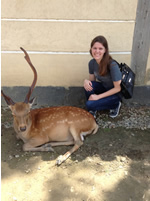
Went to Nara this weekend and befriended several deer
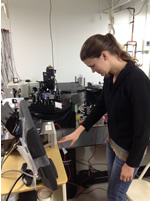
Here is a photo of me operating my favorite source meter in the whole world. It is exceptionally well behaved. Also I always have to wear a sweater in the lab because the temperature must remain at an arctic 22 degrees Celsius.
Research Update
Progress: Last week’s major accomplishment was getting the center of the sample lined up with the focus point of the laser. We were able to find the focus point of the laser by using an iris on a two dimensional stage. We adjusted the position of the iris until the amplitude of the THz wave was maximized. Then, Arikawa-sensei and I used a stage that could move in three dimensions for the sample. We used the near IR beam that is collinear with the THz beam at low power in order to “see” where the beam was hitting the sample with a camera. We knew that we would be unable to exactly line up the center of the sample in this manner because we did not want to damage the nanoconstriction with the near IR radiation. To resolve this issue, we measured the distance from the edge of the sample to the center of the sample using an electronic microscope. We lined up the beam with the edge of the sample and then filtered out the near IR radiation, and then adjusted the position of the sample so that the beam’s focus would be at the center of the sample.
The rest of the week was filled with mid-program meeting and lab visit activities.
Future Plans: Our next step is to check to make sure that the shift in the IV characteristic is a THz induced photoresponse. It is possible that the near infrared light that is scattered affects the IV characteristics of the sample. Once this has been checked, I will repeat measurements to ensure reproducibility.
At the end of the orientation, I probably spoke Japanese as well as a two year old. This isn’t to say that I didn’t have good language instruction, I had excellent language instruction, what I am saying is that Japanese is hard. Japanese is even harder if you are a shy person like me who is reluctant to attempt to speak Japanese with people. This entire summer I have been trying to get over this shyness. I am slowly improving. I self-study in my lab about an hour or so a day, and then I try out phrases with my lab-mates. My lab-mates say that I speak Japanese without an accent. I think this is because I am surrounded by Japanese constantly. None of the sounds of Japanese sound like things I haven’t heard, they just sound like things I don’t understand very well. I have much trouble speaking complicated sentences, but my lab-mates will help me. Maybe I speak as well as a three year old now. I understand on average about 15% of what is being said at any given time. This sounds depressing, but considering I’ve only truly been studying Japanese for 8 weeks, I find this to be remarkable. This statistic also hides the fact that if I have context for the situation, I can understand almost everything that is being said. It is incredible what immersing yourself in a language can do.
My most challenging linguistic experience so far was when I was traveling with Nicole. She had lost her camera in a Kobe souvenir shop. I tried explaining to the cashier what had happened and of course I didn’t know the Japanese for “lost.” So Nicole ended up looking up the phrases in her Japanese to English dictionary and we ended up finding the camera in the store’s lost and found center. This was only because Nicole and I remained calm and patient during the confusion and tried to use our resources to communicate. I learned that people communicate ideas as best they can given their limited vocabulary in a particular language, but there always seems to be positive intent. Everyone was patient with us despite our inability to communicate fluently.
I have continued with the Japanese for Busy People text book. I complete the exercises in hiragana and katakana though. During the orientation, when my language teachers would give us homework, they would give us the option to complete the homework in kana or in Romanized letters. Which do you think I chose? Unfortunately I chose to do my assignments in Romanized letters. THIS WILL NOT HELP YOU!!! After the orientation I realized that it took me a ridiculous amount of time to read anything, so I began completing my self-study in kana, which has really helped my reading speed, and I’m getting much better at writing the characters.
I would really like to continue Japanese study upon my return. I plan to keep in communication with my lab-mates and ask them to help me continue to study Japanese. I would like to return to Japan for another extended period so a larger foundation of Japanese language is necessary. I think I will try to take Japanese courses at my school as well as continue with self-study.
My Mid-Program Meeting experience was very good. I really enjoyed spending time with my fellow NJ students. They are all like family to me and I miss them already. I also learned about how everyone is adjusting to cultural issues. Chris Salinas made a very interesting comment. He said that since coming to Japan he finally understands what it means to be Caucasian, because everyone treats him the same way that they treat me. Chris Miller and Ramya both made very interesting comments about how since coming to Japan they both feel the need to prove that they are American. Since Chris is African American and Ramya is Indian American, both are commonly mistaken for not being American. For me, I think I finally understand how it feels to be a different race in some less diverse parts of the US. Growing up Caucasian in the US is not at all special and it wasn’t until coming to Japan that I experienced being a minority and being treated slightly differently, though not badly, because of my race. Honestly, I can’t complain. It can be a bit uncomfortable at times, but I realized it is hypocritical of me to be upset over a little staring because I am guilty of staring at everyone here too.
My plan for the rest of the summer is pretty simple: keep learning about culture and nanotechnology, but bump up the pace and intensity. I only have three weeks left and I need to make them count!!
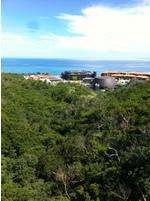
Mid-Program Meeting in Okinawa: Pictured here is the shocking beauty enjoyed by OIST’s campus on a daily basis.
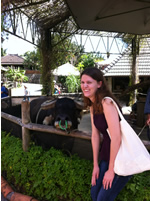
This is me with my new best friend. I don’t know her name (or if this is a her) but we definitely bonded.
As I understand it, Ms. Obokata, a 30 year old researcher for RIKEN recently published a very popular article that claimed to find a method for creating stem cells from normal cells simply by giving them an acid bath. Shortly after publication in the extremely prestigious journal, Nature, RIKEN began an investigation of her findings. Many scientists had doubts about the validity of her work and these doubts were heightened when no other scientist was able to reproduce her findings. She appealed the investigation, but still publicly apologized for her mistakes, claiming no ill will. She also said that she could prove that her conclusions were correct even if her methods were in error. RIKEN refused to re-investigate and withdrew one of her papers from publication. RIKEN is now considering disciplinary measures against her and the co-authors on the paper.
She was once heralded as the poster child of female scientists in Japan but is now publicly shamed and mocked. One newspaper went as far as to publish a close up of her face over the entire front page of their newspaper. I think the biggest issues going on in this controversy are obviously research misconduct, but beyond that, I do wonder if she would be facing so much retribution if she were a male.
I think that Ms. Obokata is very bright but maybe felt too much pressure to publish. Perhaps she felt she had something to prove, being a young female trying to make it as scientist. Also, she is clearly passionate about her research. She may have been so convinced that she was theoretically correct that she altered her results to be what she thought that they should be.
I think she probably did falsify and alter data, but I find it hard to believe that she published this with malicious intent hoping to get ahead in her career. I think that she was so convinced that her method would work that she altered her data to make it look like it worked flawlessly.
It is a shame that this has happened. She could have been a great role model for young women who wanted to become scientists. It is important that young girls have role models so that they see what it is that they can be, if they work hard. I think in America this is usually achieved with smart female characters on TV shows like NCIS and Bones. Perhaps Japan could accomplish something similar in order to encourage women to become scientists
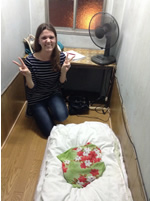
This is the smallest room I’ve ever been in that wasn’t a closet. I actually shared this space with Ramya when I missed the last train back to Kyoto and needed to stay with Ramya in her hotel room in Osaka. Ramya, Ben, Skylar, Vernon and Skylar’s roommate Eren came and visited Kansai for the weekend!
Research Update
P
rogress: This week was focused on trying to see a THz induced photo-response in the sample in the region of impact ionization. To achieve this, I first found the region of the IV curve enclosing all of the hysteresis. In other words, I found where the sample underwent impact ionization and Gunn Oscillations. When you sweep in different directions with the sourcemeter, eventually you encounter a region where each point you take depends on the previous point. This happens when there is impact ionization. Basically, it looks like a large loop in the IV curve.
After I found the region of hysteresis, I began trying to see if I could observe a change in the voltage required for impact ionization in the presence of THz. When I couldn’t, I tried to see if I could find reproducible results in the point that impact ionization would occur, without THz. I discovered that I needed to reset the sample every time I took a measurement to get somewhat reproducible results.
Then I began to measure the time-dependent current response for a particular bias. In the region of hysteresis, near the voltage for the beginning of impact ionization, the current response is bi-stable. Basically, the sample wants to be two currents at the same time, and finally it jumps almost an order of magnitude just by sitting at the same applied voltage for a long enough time. I applied THz radiation for a portion of these time-dependent studies, expecting to see that the application of THz radiation would cause the current to jump.
Changes: We did not see a response to THz radiation, but we did notice that these jumps in current appear to happen randomly in time, in other words, are stochastic. Now I will begin studying this response and see if my observations are reproducible.
This summer, we all had Japanese female researchers assigned to us as buddies in order to learn more about their experiences. My buddy is Hikaru Morimoto. She is a master course student in the Tanaka/Arikawa group. She got her undergraduate degree in physics from Kyoto University. She decided to major in physics because she just really liked math and science in school. She plans to work for a company after receiving her master’s degree.
Her work environment is the same as mine, because she works in my host lab. Hikaru-san, Naka-sensei, and I are the only females working in a lab of around 20 people. I don’t think this is so different from the US actually, especially for physics. In my lab at UF I am the only female of about ten members. I’m not saying that either of these work environments are typical, I’m just saying that from what I’ve seen, Hikaru-san’s work environment is much the same as ones I’ve experienced in the US. There are the obvious cultural differences between her lab in Japan and a US lab, but beyond that, I don’t see a difference.
There are four international students working in our lab at the moment. Two are permanent students and two (including myself) are visiting students. Hikaru-san wants to gain international experience and is trying hard to learn more English to do so. She seems interested in just learning about my daily life in the US but also about how I am enjoying Japan.
I asked her about her experiences working as a female in a male dominated field. We were at a party for the physics department and women consisted of about 8% of the crowd. She noted that there weren’t very many women there, and I asked her if she thought being a woman studying physics was difficult. She very matter-of-factly told me that it was not.
Hikaru-san is not shy at all, which kind of surprised me at first. I was so shy my first day in the lab, but she just walked up to me and asked me if I was supposed to be her buddy, in English. I could have never had the courage to do so in Japanese. Then she invited me to her house for dinner the next night. This week, she and I are going to a festival together too. I’ve really enjoyed getting to know her because she is extremely kind and I will miss her!
Last weekend I went and saw the bamboo forest in Arashiyama that is on every Japan travel guide book ever. It was really awesome!
Research Update
Progress: This week I worked on measuring the time-dependent current response at different applied biases. I was measuring how long the sample took to undergo impact ionization. Below are the preliminary results of my experiments. I used pins 7&12 in the positive bias region.
Setbacks: The program does not seem to keep uniform time. Usually the data is acquired between 800 and 850 seconds, but sometimes can take as long as 1500 seconds, even though the same step delay and number of points are requested.
What has changed the most about your perceptions and attitudes towards Japan?
Honestly, before coming to Japan, I don’t think I really had expectations or attitudes towards Japan. I was excited to go, and I knew it would be really cool to live there, but I didn’t really have a set idea. Now, I feel an attachment to Japan. The people here and the experiences I’ve had, really, it sounds cheesy, but I definitely lost a part of my heart to Japan. In addition to all of the good memories, and friends I have made, I have a newfound interest in East Asian culture and language that I never expected to have.
What has changed the most about your perceptions and attitudes towards the US?
Learning so much about another culture made me realize that the US really does have a culture and a cuisine. I never knew that I would miss the comforts of home, nor did I even realize that they were comforts. For example, how many pillows do you sleep with? If your answer is greater than one, you may be a bit disappointed with the pillow amount in Japan. Also, do you like getting free bread with your meal? That isn’t going to happen in Japan either. These are such minor differences, but I didn’t even know that they were differences to begin with. Little things like this taught me so much about my own culture and food.
What has changed, if anything, about you personally? Are you a different person in any way from when you first came to Japan?
I think my personality has changed a bit, though I am still way too close to the situation to properly assess in which way. I think I have learned to become a more respectful person in a lot of ways, for one. I also think that I have become more open-minded. Adopting a “when in Rome” attitude for three months can really change what you think of your identity.
What were the most common daily frustrations you experienced with living in Japan? What did you learn from these experiences?
Some common daily frustrations I dealt with, and this will sound shallow, is how unattractive I constantly felt. Japanese women dress extremely well, so I always felt underdressed in jeans and a T-shirt. Additionally, though I am considered a pretty small person by American standards, I asked my lab mates, and I’m the same size as a medium-sized MAN in Japan… These two things together sort of made me feel not all that confident.
Another frustration I dealt with is having to hide all of my negative emotions. I could not express anger or frustration without seeming rude. Of course with my closer lab mates, I could tell them that I was upset over a particular event, but I still couldn’t appear angry or bothered in my mannerisms. This was nice, because I really don’t like seeing people be angry, but on the other hand, I’m used to being able to vent my frustrations to someone.
What will you miss most about living and working in Japan?
Literally everything. I’m crying. I do not want to leave.
How did this experience affect your attitudes towards academic research and your career goals?
Although my project was frustrating at times, I definitely enjoyed doing research, and I am without a doubt going to continue my career in research. I had this career goal before NanoJapan, but I definitely think that this experience confirmed my plans.
Describe your final week in the lab. What arrangements have you made to say goodbye to and thank your research group or those who have assisted you during your stay at your host institution? Did you have a going away party?
My final week in lab flew by. I was both working frantically to finish my project, but also slowing down to spend time with my lab mates while I still could. I did have a going away party and I also made sure to write thank you notes to those who had helped me a lot, or to those with whom I had grown close. I got a couple of gifts for the lab-mates with whom I was closest.
During this week I also went to the Mitarashi festival with lab-mates and it was really fun. It is a festival celebrating health and is held during the hottest time of the year. To combat the heat, you wade into a really really cold pool up to your knees. You also buy kakigori (Japanese shaved ice.)
I had another cultural incident at the end. After my going away party, which was on Monday, I needed to say goodbye to a couple of my lab-mates who I would not see again. After my host-family had been so eager to hug me, I thought that I could give my lab mates hugs, even though the Japanese DO NOT hug anyone who isn’t their significant other. I asked Tomo-san if I could hug him, and he agreed, but he seemed hesitant, it was sort of too late to change my mind so I briefly hugged him. Everyone around us made “oooo” sounds like we were 12 year olds who had just kissed. I think they thought I was hitting on him. So I explained that this was how Americans say goodbye, we hug everyone, that hugs are general not just for significant others. So I hugged Terao-san briefly too, he seemed more comfortable, after I had explained. Another lab-mate who I actually wasn’t even saying goodbye to hugged me as well, but Hiraoka-san refused because he has a girlfriend. Basically, I learned that if I’m going to hug people, I need to make sure they know that for Americans, hugs are for anyone you are sad to say goodbye to. I wrongly assumed that my lab-mates were aware of this American custom, and it resulted, unfortunately, in much embarrassment for me and for Tomo-san.
How did you close out your research project and do you plan to remain in contact with your research group and/or host? Do you plan to continue this research project or research in a related area upon your return to your home university?
I do plan to remain in contact with Arikawa-sensei and am friends with many of my lab-mates on Facebook. I plan to keep in touch with everyone because we have all become such good friends. My research at the University of Florida is related in the sense that it is centered around a similar material, but the methods are very different. So in short, I will somewhat be continuing my research project when I return to the US.
What are your plans for your final weekend in Japan?
Friday night, I will be staying at a Ryokan (Japanese traditional hotel) on Koyasan, then on Saturday, I will be climbing Fuji-san with my favorite nano-scientists!
NanoJapan Research Symposium Summary
The NanoJapan Research Symposium in Tokyo began with a very interesting talk from the NSF director in Tokyo. Dr. Kellina Craig-Henderson discussed how science has become increasingly international and especially highlighted Japan and US relations in regards to science. We then proceeded with an overview of the NanoJapan program and each of the NanoJapan students gave a presentation. I thought each of the NJ presentations were good and appreciated that the audience was expected to ask questions. I also really enjoyed that we got to hear from the mentors too but would have appreciated hearing even more about their experiences working with an American student.
Finally, we heard about additional opportunities to do research in Japan, heard from a panel about international research collaboration, and then Dr. Matherly discussed the great statistics of the program. One key thing that I found to be quite shocking was that many students scored very highly on Japanese language tests at the end of the program, even though they had no prior language experience. In fact, the great majority of students walked away with the equivalent of a semester or two’s worth of Japanese language knowledge. Another key takeaway for me is that there are ample opportunities to return to Japan, which is great, because I sincerely hope to do so.
Final Research Project Overview
Research Project Title: ![]()
Host Lab:Solid State Spectroscopy Group, Kyoto University
Host Professor/mentor: Prof. Takashi Arikawa
The problem we were hoping to address is that Gunn Oscillations have not been observed or understood in the nanometer scale. I was hoping to further understand the nature of the impact ionization and Gunn oscillations in this GaAs heterostructure sample with a nanoconstriction. If we were to succeed in achieving Gunn oscillations in a nanometer scale, we could have a THz source. We could also potentially use the nonlinearities in the current-voltage curve as a THz detector.
Our initial approach was to try to reproduce the current-voltage characteristics in the sample. We noticed that the large jumps in current, the impact ionization, were not very reproducible. The impact ionization would onset at different applied biases each time we did an experiment. We noticed that if we reset the sample by exposing it to light for 10-15 minutes, and eliminating its electrical contact for that period of time, the voltage for onset would be rather reproducible within one volt, but for noticing the small changes that THz would cause, this is still too unreproducible. We decided to move forward with studying this problem of random onset of impact ionization.
First we studied the time dependent current response to a bias. For this, we swept up to a particular voltage, and then sat at that voltage for about 15 minutes while measuring the current. We noticed that Gunn oscillations would begin in the sample, followed by impact ionization, simply by waiting.
Second, I studied the sweep rate dependence. As I slowed the rate at which I applied voltages, the region of hysteresis of the sample is greatly affected. It seems as if as I sweep more slowly, the sample becomes more stable in the region of hysteresis and the voltage required for the onset of impact ionization is pushed back further.
Third, I studied the effect of Near Infrared Radiation (IR) on the current-voltage characteristics of the sample. With the Near IR, the overall current of the sample was higher because the photon energy excited electron-hole pairs across the nanoconstriction. In addition, the voltage required for the onset of impact ionization was shifted to lower voltages beyond the error of the stochastic behavior.
All of these experiments pointed to the fact that the impact ionization occurred randomly in time in the sample. The sweep rate is one way in which to somewhat control the voltage required for the onset of impact ionization. The effect of the near IR is to cause the impact ionization to occur sooner. Because the sample is already unstable, the near IR provides enough energy to “push” the sample to impact ionization.
In the immediate future, further work should be down to characterize the power dependence of the near IR induced photocurrent. I would expect that as the power of the Near IR irradiation is decreased, the photo-response will be much weaker and the shift in the onset of impact ionization will be less dramatic. Future work, further down the line, should focus on exploiting or controlling this random behavior for THz detection.
When speaking to a family member, I would probably highlight the cultural elements that I learned from NanoJapan. I would discuss how I learned so much more about myself than I ever thought possible in such a short period of time. For example, I learned that I am capable of communicating with someone without relying on my native language. I am capable of assimilating to a completely different culture and a completely different lifestyle. I am also capable of change. Before my experience with Japan, I really hated change. In fact, one of the reasons I decided to do NanoJapan was because I knew that change was uncomfortable for me and I thought that the best way to address this discomfort was to embrace it in the most extreme way. I thought there was no way I could change my life more than going to Japan for an extended period. Now, I am a big fan of change. Japan changed my life in the most wonderful way and now that I have had such a positive experience with change, I no longer fear it quite so much.
I also gained a large sense of humility from the program. I have never had to ask for so much help in my life. I am actually really uncomfortable asking for help in the US. I always just try to figure out whatever problem I’m having on my own, but in Japan, I couldn’t even read my own mail. I used to have to give my mail to my lab mates and ask them to translate it for me. When we went to restaurants without English menus, I used to need my lab mates to translate the names of the dishes for me. I needed help finding grocery stores, paying bills, and needed help finding the nearest bus stop. In the US, I am fully capable of taking care of myself and all of these tasks are very trivial for me, but in Japan, I needed this help. It was so humbling. Thankfully, I was surrounded by wonderful people who didn’t make me feel stupid for needing so much help. They were so happy to drop whatever it was they were doing to assist me with any matter.
Finally, I learned so much about my home culture. Seeing the contrasts between Japanese culture and American culture taught me so much about why I am the way I am. In addition, when I made a cultural mistake, it taught me even more about the differences between my host culture and home culture. For example, when I was first showed to my apartment by the realtor and my mentor, I walked in, and forgot to take of my shoes. I was met with some surprise on the part of the realtor and raced back to the front door to take off my shows with many “sumimasen”s. Now why was it that I thought it was completely okay to walk into a home with my shoes on? I never even thought about shoe-removal practices of the US, but now I was confronted with needing to understand why I didn’t remove my shoes, so that I could change my habit to remember to remove my shoes in the future. A lot of things I learned about Japanese culture, I initially thought were weird, for example, I thought it was strange that the number four was considered taboo, but then I realized, wait, Americans think the number 13 is taboo, that must seem weird to Japanese.
When speaking to a professor, I would highlight the scientific skills I learned from NanoJapan, and the transferrable soft skills that I learned. I would also likely toss in a funny cultural anecdote. To go in to more detail, I would describe my project (in broad terms-studying transport phenomenon in nanostructured semiconductors.) I would explain that I now have experience with THz emission/detection, studying current voltage characteristics, and have a greater understanding of quantum mechanical processes.
The transferrable skills soft skills I would discuss would be my more respectful demeanor, my enhanced professional communication and presentation skills, and my adaptability skills. I would also likely cite my new language skills and greater overall cultural awareness. In total, I would say I would discuss 60% scientific skills, 40% transferrable soft skills.
The anecdote I would use would probably be the time that I tried to order and coffee with milk. I asked the waitress for a “kohi to mikuru” literally “coffee and milk” and the waitress brought me a cup of milk and a cup of coffee. Not wanting to cause further confusion, I sort of just mixed the two. This is something I think everyone can relate to and is a good example of the language barriers I was dealing with on a daily basis.
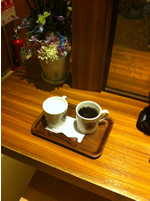
Oh language barriers…
When speaking to an employer, I would highlight the same skills I would with a professor, except in this case I would likely discuss 65% soft skills and 35% scientific skills. The adaptability skills I gained as a part of the program are quite rare, and these are skills I want to be sure to discuss in any future interview. Any employer will not be concerned with my adjusting to their work environment, when I have adjusted just fine to an environment on the other side of the world. I say this not to brag about myself, but to brag about what you gain from the program.
I would also discuss my experience working on an international team. In this day, it is almost impossible to find a job that will not involve work with international colleagues, especially in science. To now have this sort of experience is something I think any employer would appreciate.
When speaking to a fellow student, I would say what I gained from NJ was a better sense of both culture and science. I would probably give a less personal explanation than what I would give my family members, but still cover the same essential points. I would say that it was an incredible experience and if they have any inclination to do research in one of the coolest places on earth, then they should definitely check into further detail.
Even though the students I will be describing this program to will likely be students pursuing science degrees, I am sure that everyone’s first question will be “how was Japan?” or some derivative of that. To be honest, I can’t even think of a word that describes the entire experience of living in Japan. I would say “awesome” but this word is so overused and sounds insincere, even though I sincerely mean it. To answer this question more adequately, I would probably say that living in Japan was an incredible experience and that I miss it on a daily basis. I would say that I gained a great deal from how kind and respectful everyone is to each other in Japan, and that I loved the intense beauty of the country. That I enjoyed the food, the convenience of everything, and the happiness of all the adventures I got to have.
To go into more detail, I would probably also highlight the great friends I made as a result of my participation, both with NJ students and lab-mates. I would explain that I have several contacts now, not only all over the country, but also all over Japan.
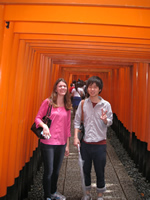
Me with my new colleague and former lab-mate, Ichii-san, from the Tanaka/Arikawa lab at the Fushimi Inari Shrine
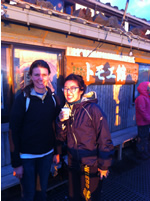
Me with my new colleague and fellow NJ student Lisa Chiba near the summit of Mt. Fuji
As a result of my participation with NJ, I am now so much more internationally focused. Before my participation with NJ, I thought that I would no longer feel such a strong wanderlust after spending three months in Japan, but it has had the opposite effect, instead I have found a new passion for travel and experiencing other cultures that I did not have before. Going to Japan this summer was actually a rather liberating experience. I realized that I do not have to be limited to the US. I could potentially get my post doctorate degree abroad, or have a job abroad. I do not have to live in the US for the rest of my life. It isn’t that I don’t like the US, I love my country and I will always be an American, but I have always craved different experiences, and now that craving is far more intense. I have a passion for learning, it is why I want a career in research, and why I enjoyed Japan so much. Every day in Japan, I learned at least ten new things, whether about science, language, or culture. In the US, I don’t have as easy a time learning about a new culture or foreign language. I am considering taking more Japanese classes, and if this is not possible due to scheduling conflicts, I fully intend to continue my self-study.
Right now the only burning question I have in regards to Japan is when do I get to return?
Pre Departure Tips
Study Japanese. I know this one is obvious, but still, you need to do it. I would highly recommend learning some of the most useful Kanji: for example, the Kanji for Tokyo, your host city, and any cities you plan to travel to. Also learn the Kanji for the cardinal directions. Of course the train/subway message boards will display in English, eventually, it can mean the difference between making the train, or missing the train because you were waiting for the message board to translate.
Pack shorts. I went the whole summer without shorts because I was told shorts weren’t worn very often, except to the beach. This is somewhat true, but they are so much more comfortable than long pants when sightseeing. It’s like the equivalent of wearing overalls in the US. They aren’t very popular, but some people look alright in them. Just buy a respectable pair of shorts for the weekend trips you will take.
Some more obscure tips: Bring your own shampoo and conditioner from home. Unless you are Asian or you have very tolerant hair, the products in Japan will likely not agree well with your hair. Also, bring peanut butter. Peanut butter is very expensive (five dollars for a mini jar) and hard to find in Japan.
Finally, I would recommend not buying a full JR pass. You will likely want to exchange your pass at the end of the summer to get back to Tokyo, but at this point in time, you will also be tired, potentially working on your project over the weekend, and wanting to spend your last weekends with your lab-mates. I ended up visiting Sendai with my JR pass, which was fun, but I only stayed for dinner, and then I had to leave early the next morning. I would have preferred to have stayed in Kyoto area that weekend and just bought a shinkansen ticket back to Tokyo separately.
Orientation Program Tips
For your time in Tokyo, it will be packed. This is the largest amount of time that all the NanoJapan students spend together, so do your best to take advantage of the bonding time. The friendships you make in these three weeks are surprisingly strong and will come to your aid throughout the summer. For example, Nicole Moody was my travel partner this whole summer. I wouldn’t have seen half of Japan without her, so I’m very glad we got off on good terms in Tokyo.
Beyond this advice, try to work hard at doing more than the bare minimum in terms of your Japanese homework. Also make sure you are sleeping enough. Explore Tokyo as much as you can, because it is a really cool city. Finally, if you need a chill and recharge day, just take one. There are a couple of free days built into the program and there is no shame in just admitting that you need some time to recharge
Mid-Program Meeting Tips
For the mid-program meeting, try to take advantage of this time to reconnect with your fellow NJ students. You likely haven’t seen each other for a month, and this is valuable time to learn from them what is or isn’t working for them in their research labs.
Working With your Research Lab Tips
For integrating into the Tanaka/Arikawa lab, I recommend simply stating that you want to see everything you can in Kyoto and you would be very happy if any lab mate would go sightseeing with you. In this way, I think I spent a part of almost every weekend with my lab-mates. Make sure you go to group lunch as much as possible. The food in the cafeteria is really cheap and good and even though everyone will likely be speaking in Japanese, this is a valuable time to learn about the group dynamics and to make sure it is apparent that you are making an effort to fit in. When you begin to eat, put your hands together in front of your chest, bow slightly, and say “itadakimasu” and when you finish, again put your hands together and say “gochiso sama deshita.” This is the equivalent to saying grace.
One thing I wish I had done differently was start out attempting to use Japanese whenever possible. Even if the rest of your sentence is in English, just using one word you know the Japanese for will show that you are making an effort. They are already making the effort to speak English with you, so you should do everything you can to reciprocate that. I think many of my lab mates shied away from me at first because I wasn’t using enough Japanese. Towards the end of the summer, when I was speaking more Japanese, I became closer to them though.
Living in your Research Host City
Kyoto was amazing, and I was so fortunate to be able to call Kyoto my home for 8 weeks. Some tips: learn the bus system. Get a bus map, and understand how to use them. Kyoto is a bus city, not a train city. Two: just ride your bike anywhere. In this way, you will likely stumble upon useful things like 7/11s and grocery stores, but also a famous temple or shrine.
I would highly recommend checking out the Fushimi Inari Shrine, Otsu, and Arashiyama
My housing had bedding, but no towels. Bring a towel from home just to be safe. Also, your bed will only come with one pillow. I brought one of those plane-neck-pillow things from the US and was really glad I did.
Language Study Tips
So, Kyoto University offered Japanese classes but the deadline to sign up was in April. If you can, ask Arikawa-sensei about language classes as soon as you find out you have been placed in his lab, so that maybe you could take classes through the university. The international center had language classes, but it was kind of far away (like 25 minutes by bike in the extreme heat of July) so I only went to the class once. For the rest of my study, I just used the Japanese for Busy People text book and asked my lab-mates questions on certain phrases. I learned a lot this way. My lab-mates were really happy to see that I was interested in learning Japanese and so were happy to help.
What Gifts to Bring
For Arikawa-sensei, definitely bring him something from your home university. I just got him a Florida themed plastic coffee mug and it kind of just sat on his desk the whole summer. I think it would have been better if I had gotten him a higher quality souvenir from UF. Over the course of the summer, I got him other gifts that I hope made up for it. I got him a really beautiful book mark from Nara, and a little stone placed near a child’s bed to bring good health from a shrine in Kyoto. This gift meant a lot to him, because he had his first child in September 2015. For the rest of the lab, I brought tea from Kyushu and American Candies.
For the tea: for other labs this would have worked, because other labs just readily have tea available made by the secretaries. For the Arikawa-lab, this didn’t work. Instead, my gift of tea went largely unused because the tea came in one large brick-like structure that no one wanted to take tea from, for fear of seeming greedy. For the American candies: I think they went over okay. It took a while for the packs to be finished though. I think I made up for my initial gift mishaps by giving better souvenirs throughout the summer.
What to Eat
Everything. Don’t question it. I tried so many dishes, and I only know the name of about half of them, but they were all awesome. Try Japanese BBQ especially. I feel like a traitor for saying this, but I think it was better than American BBQ. Also, you must, must, must try a Kobe Beef lunch.
What to Buy in Japan
Bad English T-shirts. They are hilarious and make for good conversation starters. Try not to wear them to lab though. I’m not sure, but I think some of my lab-mates would have been offended if I had. I also recommend purchasing the different flavors of kit-kats made in Japan. They make for excellent souvenirs.
What to Do in Japan
Visit the major temples and shrines in Kyoto and Nara, they are very historic and beautiful. Also, visit a sake brewery museum. There is a good one in Kobe, the Hakutsuru museum. Sake is very difficult to make and it was really interesting learning about the process. For your last Friday night, I recommend staying with monks in a traditional Japanese inn on Koya-san. It was the same price as an American hotel, but came with dinner, breakfast, and free use of the onsens.
Places to Visit in Japan
Beyond the obvious major cities, definitely check out Otsu. It is off the beaten tourist path, but is truly incredible.